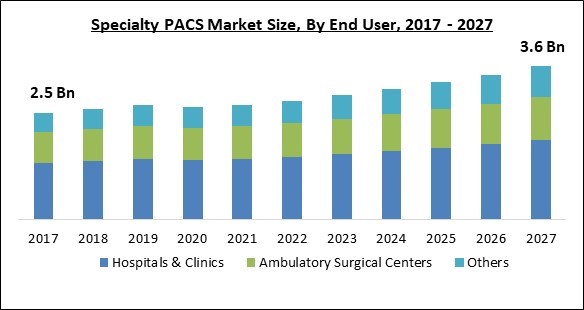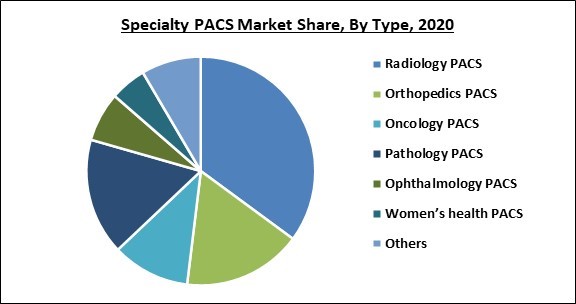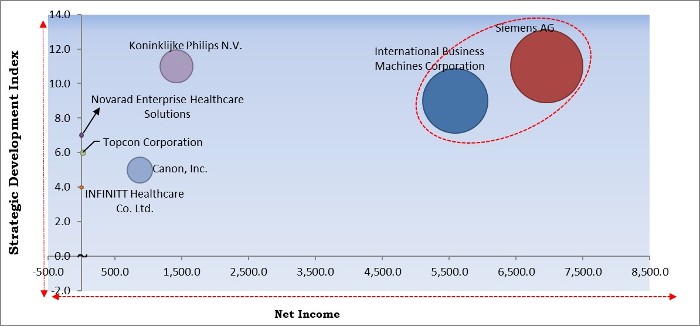The Global Specialty PACS Market size is expected to reach $3.6 billion by 2027, rising at a market growth of 4.9% CAGR during the forecast period.
The enhancements in biomedical technologies have improved the way of doctors analyze patients’ data. The PACS systems are one of such technological advancements. PACS refers to picture archiving & communication skill systems, which is an imaging technology mainly used by the healthcare industry.
The PACS helps in the transmission of the image from the site of acquisition to multiple locations that require the image. The picture archiving & communication system is capable to access multiple models like CT, radiographs, ultrasound, and MRI at the same time on multiple locations within the hospitals as well as across different areas.
The main function of PACS is to make image viewing easier and help to manage the medical data. For example, to match the requirements of technology in the healthcare sector, the JPI healthcare solutions designed ExamVue PACS. The ExamVue PACS can be used by large as well as small hospitals with a limit of 10 viewers. This software can easily be installed across the office to show the x rays of patients as well as to perform diagnoses in the private office.
The World Health Organization predicts that the population of people with the age of 60 or more will increase up to 2 billion by 2050 in the world, which would result in the demand for healthcare services. Moreover, the increasing investment in medical imaging will boost the demand for specialty PACS. The major factor responsible for the increased load on healthcare sector is the rising number of scans among various small & large medical facilities.

The outbreak of the COVID-19 pandemic has impacted almost all the industries across the world. The pandemic has brutally affected the specialty PACS market which has recorded a decrease in the demand for PACS devices.
In addition, the disturbance in import & export of raw material as well as final products, less production due to the complete lockdown along with various other restrictions imposed by the government authorities resulted in disrupted supply chain. Also, the increased number of healthcare workers falling ill in the pandemic has led to the less productivity. The decline in hospital visits due to the risk of coronavirus spread has resulted in reduced demand for PACS systems in the market.
The number of aged population is continuously rising in the world. Various problems are accompanied by the aging of the musculoskeletal system which results in changes in bones and soft tissues. The risk of fractures due to alteration in bone-like osteoporosis & osteomalacia is more in old age people. Osteoarthritis is one of the common musculoskeletal diseases found in the elder population. Thus, the surgeries in old age people is also high due to high spread of chronic diseases.
The adoption of picture archiving & communication systems (PACS) has changed the working style of the healthcare industry. The technological advancements have made it possible for physicians to share medical images report electronically with ease and in less time with the help of PACS systems. The main advantage of PACS systems is that it provides digital imaging which enables medical professionals to have a closer and clear look at images.
Instead of various benefits associated with the use of PACS systems for imaging, the PACS system can also be a confusing decision for the radiology providers and outpatient imaging centers. Each center deals with the different situations and thus requires different specialized solution. The PACS systems mainly focus on the needs of radiology facilities of healthcare centers, whereas the administrators of imaging centers do not have the same requirements as hospital administrators which sometime make the PACS system inefficient for such imaging centers.

Based on the deployment model, the specialty PACS market is fragmented into on-premises specialty PACS, cloud-based specialty PACS. In 2020, the on-premises specialty PACS segment dominated the specialty PACS market by generating the highest revenue share. This dominance is because of the spread of various chronic diseases in both developing & developed countries, growing demand for medical imaging, and various initiatives taken by the government.
On the basis of type, the specialty PACS market is segmented into radiology PACS, orthopedics PACS, oncology PACS, pathology PACS, ophthalmology PACS, women’s health PACS. The orthopedics PACS segment acquired a significant revenue share in the specialty PACS market in 2020. Increasing demand for making image integration flexible which lets the surgeons easily access images from anywhere has grown the adoption of specialty PACS systems in orthopedics.
By end user, the specialty PACS market is categorized into hospitals & clinics and ambulatory surgical centers. In 2020, the ambulatory surgical centers segment accounted for a significant revenue share in the specialty PACS market. These are the modern healthcare facilities providing same day diagnoses because of the lesser stay time of patient they require to have a fast and efficient technology for imaging which is increasing the demand for of PACS systems in this segment.
| Report Attribute | Details |
|---|---|
| Market size value in 2020 | USD 2.6 Billion |
| Market size forecast in 2027 | USD 3.6 Billion |
| Base Year | 2020 |
| Historical Period | 2017 to 2019 |
| Forecast Period | 2021 to 2027 |
| Revenue Growth Rate | CAGR of 4.9% from 2021 to 2027 |
| Number of Pages | 226 |
| Number of Tables | 383 |
| Report coverage | Market Trends, Revenue Estimation and Forecast, Segmentation Analysis, Regional and Country Breakdown, Competitive Landscape, Companies Strategic Developments, Company Profiling |
| Segments covered | Type, Deployment Model, End User, Region |
| Country scope | US, Canada, Mexico, Germany, UK, France, Russia, Spain, Italy, China, Japan, India, South Korea, Singapore, Malaysia, Brazil, Argentina, UAE, Saudi Arabia, South Africa, Nigeria |
| Growth Drivers |
|
| Restraints |
|
Region wise, the specialty PACS market is analyzed in North America, Europe, Asia Pacific, and LAMEA. In 2020, the North America region emerged as the leading region in the specialty PACS market with the largest revenue share. This is because of the rise in the availability of better health care facilities & skilled medical professionals along with the increasing investment by the government in the healthcare industry in the region.
Free Valuable Insights: Global Specialty PACS Market size to reach USD 3.6 Billion by 2027

The major strategies followed by the market participants are Partnerships. Based on the Analysis presented in the Cardinal matrix; International Business Machines Corporation and Siemens AG are the forerunners in the Specialty PACS Market. Companies such as Canon, Inc., INFINITT Healthcare Co. Ltd. and Topcon Corporation are some of the key innovators in the Market.
The market research report covers the analysis of key stake holders of the market. Key companies profiled in the report include Novarad Enterprise Healthcare Solutions, Escalon Medical Corp., IBM Corporation, Siemens AG, Canon, Inc., INFINITT Healthcare Co. Ltd., Koninklijke Philips N.V., McKesson Corporation, Carestream Health, Inc., and Topcon Corporation.
By Deployment Model
By Type
By End User
By Geography
The global specialty PACS market size is expected to reach $3.6 billion by 2027.
Increasing geriatric population are driving the market in coming years, however, inefficiency of PACS systems limited the growth of the market.
Novarad Enterprise Healthcare Solutions, Escalon Medical Corp., IBM Corporation, Siemens AG, Canon, Inc., INFINITT Healthcare Co. Ltd., Koninklijke Philips N.V., McKesson Corporation, Carestream Health, Inc., and Topcon Corporation.
The Cloud-based market shows high growth rate of 7.5% during (2021 - 2027).
The North America market is the fastest growing region in the Global Specialty PACS Market by Region 2020, and would continue to be a dominant market till 2027.
Our team of dedicated experts can provide you with attractive expansion opportunities for your business.

